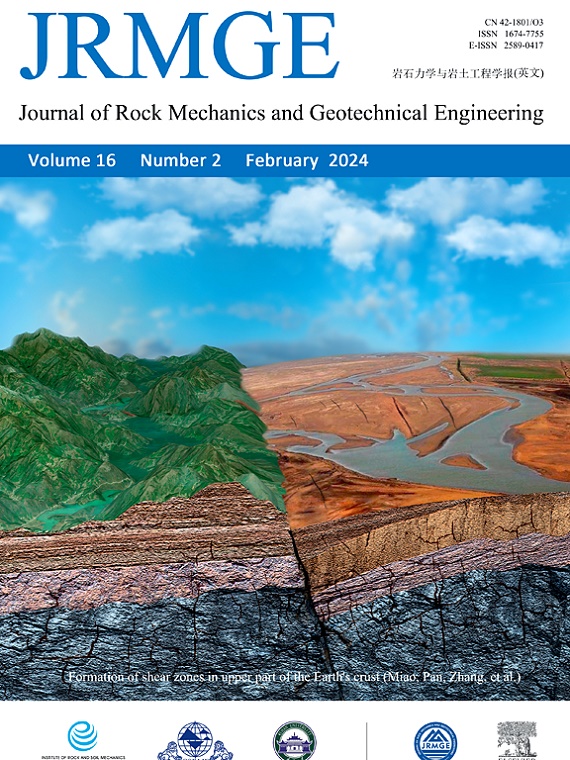A coupled cryogenic thermo-hydro-mechanical model for frozen medium: Theory and implementation in FDEM
IF 10.2
1区 工程技术
Q1 ENGINEERING, GEOLOGICAL
Journal of Rock Mechanics and Geotechnical Engineering
Pub Date : 2023-11-01
DOI:10.1016/j.jrmge.2023.09.007
引用次数: 0
Abstract
This paper presents the development of a coupled modeling approach to simulate cryogenic thermo-hydro-mechanical (THM) processes associated with a freezing medium, which is then implemented in the combined finite-discrete element method code (FDEM) for multi-physics simulation. The governing equations are deduced based on energy and mass conservation, and static equilibrium equations, considering water/ice phase change, where the strong couplings between multi-fields are supplemented by critical coupling parameters (e.g. unfrozen water content, permeability, and thermal conductivity). The proposed model is validated against laboratory and field experiments. Results show that the cryogenic THM model can well predict the evolution of strongly coupled processes observed in frozen media (e.g. heat transfer, water migration, and frost heave deformation), while also capturing, as emergent properties of the model, important phenomena (e.g. latent heat, cryogenic suction, ice expansion and distinct three-zone distribution) caused by water/ice phase change at laboratory and field scales, which are difficult to be all revealed by existing THM models. The novel modeling framework presents a gateway to further understanding and predicting the multi-physical coupling behavior of frozen media in cold regions.冻结介质的低温热-水-力耦合模型:理论与FDEM实现
本文提出了一种耦合建模方法来模拟与冷冻介质相关的低温热-水-机械(THM)过程,然后在多物理场模拟的组合有限-离散单元方法代码(FDEM)中实现。控制方程是基于能量和质量守恒,以及考虑水/冰相变的静态平衡方程推导出来的,其中多场之间的强耦合由关键耦合参数(如未冻水含量、渗透率和导热系数)补充。该模型通过室内和现场实验进行了验证。结果表明:低温THM模型可以很好地预测冻结介质中观察到的强耦合过程(如传热、水迁移和冻胀变形)的演化,同时作为模型的突现性质,也能捕捉到现有THM模型难以全部揭示的实验室和现场尺度上由水/冰相变引起的重要现象(如潜热、低温吸力、冰膨胀和明显的三带分布)。这种新的建模框架为进一步理解和预测寒冷地区冻结介质的多物理耦合行为提供了一个途径。
本文章由计算机程序翻译,如有差异,请以英文原文为准。
求助全文
约1分钟内获得全文
求助全文
来源期刊

Journal of Rock Mechanics and Geotechnical Engineering
Earth and Planetary Sciences-Geotechnical Engineering and Engineering Geology
CiteScore
11.60
自引率
6.80%
发文量
227
审稿时长
48 days
期刊介绍:
The Journal of Rock Mechanics and Geotechnical Engineering (JRMGE), overseen by the Institute of Rock and Soil Mechanics, Chinese Academy of Sciences, is dedicated to the latest advancements in rock mechanics and geotechnical engineering. It serves as a platform for global scholars to stay updated on developments in various related fields including soil mechanics, foundation engineering, civil engineering, mining engineering, hydraulic engineering, petroleum engineering, and engineering geology. With a focus on fostering international academic exchange, JRMGE acts as a conduit between theoretical advancements and practical applications. Topics covered include new theories, technologies, methods, experiences, in-situ and laboratory tests, developments, case studies, and timely reviews within the realm of rock mechanics and geotechnical engineering.
 求助内容:
求助内容: 应助结果提醒方式:
应助结果提醒方式:


